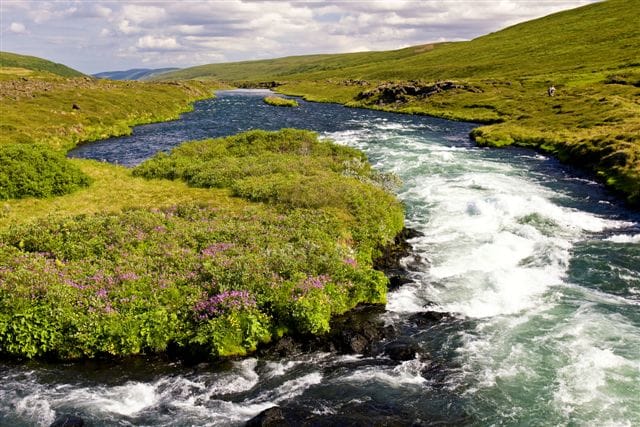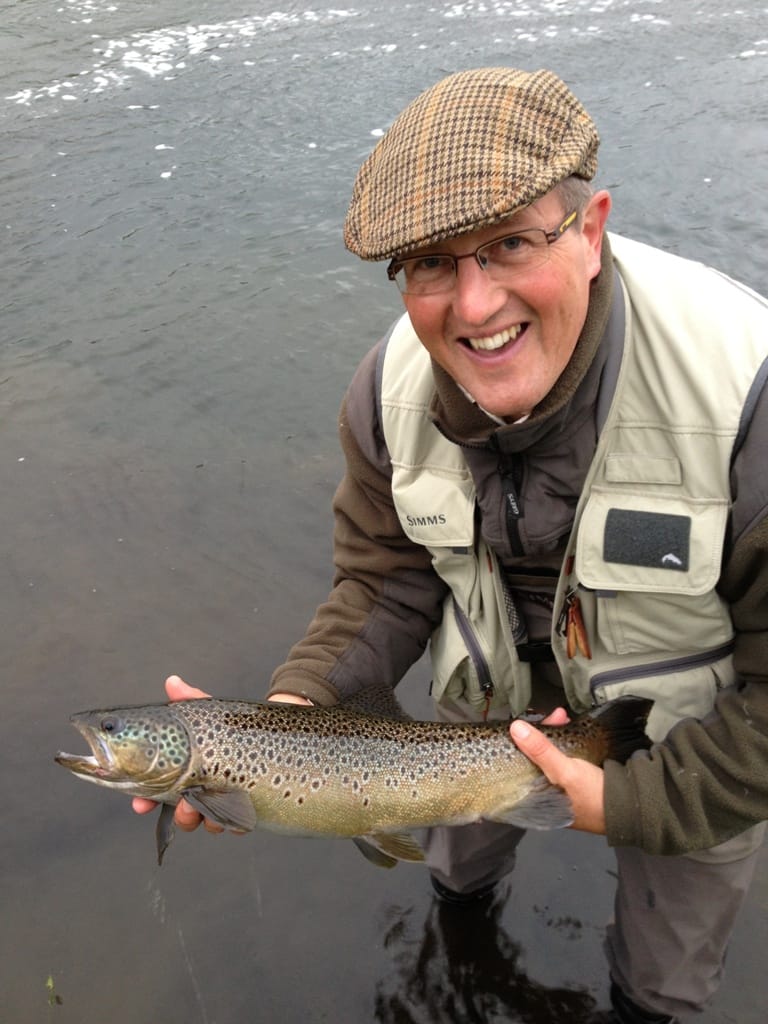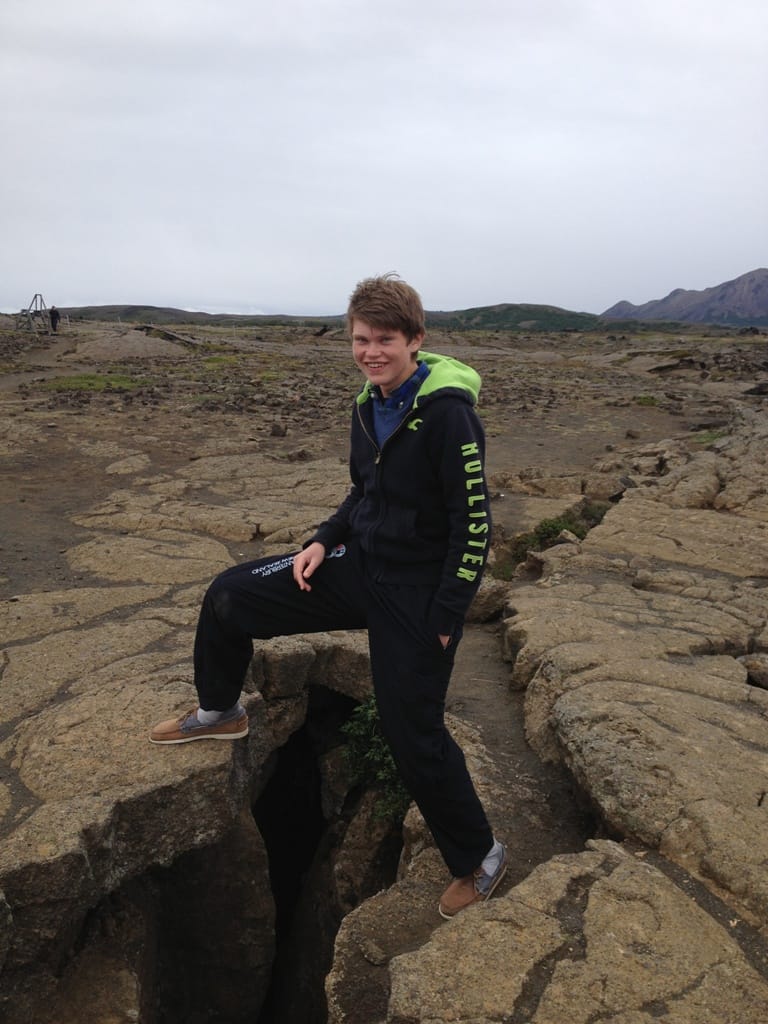Day 1 Tuesday, July 30
Guy and I spent the morning relaxing in the very comfortable Holt hotel in Reykjavik – Guy practiced his knot tying. After a short flight we were delivered to Akureyri and met up with, our guide, Ari without difficulty, both Guy and I instantly took to Ari who proved to be a wonderful guide.
We arrived at the Hof lodge, on the Myvatnssveit trout beats, just in time to unpack our fishing gear and set out for the afternoon session. We had a downstream beat in the valley based around a 5 km long island between two wonderful streams full of fantastic pools. It is hard to describe the impact of the river on first sight. It is reminiscent of a large river in Scotland but the water is clear rather than brown but has a dark appearance due to the bed of lava sand. The vegetation is profuse but treeless and the birdlife completely remarkable. I felt disorientated at first not knowing how to fish this water. After watching a pool for a short time from a lava outcrop we saw a fish rise in the tail of the pool. Guy went down with Ari and put a size 16 black klinkhammer over the fish with a good cast from the bank. The fish showed to the fly (I was watching through binoculars from the head of the pool) but did not take it on the first cast and then took it on the second cast. In a Scottish river that rise would have been associated with a fish of less than 1 lb but the fish that then erupted from the water was 4-5 lbs and it gave Guy the shock of his life! After a relentless struggle the fish moved to run down a rapid on the opposite side of the island between him and Guy and the hook came free. That was the second cast of the day!
We move down the island fishing some pools as we went. Rising fish were scarce and we started fishing with a Chew Valley bibio hopper as a dry strike indicator with a small nymph tied 1.5 feet below it. We had little success with this technique and I noticed that if the fly was allowed to drop below in the current I had a couple of follows. We then developed a technique in which we used a gold head on the point to anchor a bibio hopper fished as a spider on the dropper 1.5 feet up the leader and well below the surface. This rig was fished across and down with remarkable success. Interestingly the fish nearly always took the spider (bibio hopper) not the gold head. In a very long pool Guy had four fish at the head of the run up to 3.5 lbs and I hooked a monster in the middle of the pool. We had switched rods and I was using my old 8.5 ft foot Hardy dry fly rod. The fish took at 45° downstream and jumped clear of the water on the strike and then ran me straight down well into the backing. Ari got to me with the net after a ferocious struggle and a 5lb fish was landed.
Working back up the other side of the island I subsequently hooked another very large fish which took the flies as soon as they hit the water when I had just dropped a short line on the pool while working out a longer line for the first cast. This fish shed the hook, but shortly afterwards I had another thumping take midstream and after another eye-opening battle-royal with an extremely determined fish a 5.5 lber was landed. We fished until 10pm and later on a cold wind started to blow up the valley and both Guy and I found ourselves insufficiently dressed for the extremes of Iceland. Returning to the lodge for a good late meal we had recorded Guy: 7 fish up to 3.5 lb, I had six fish including 2 of 5 lbs and over.
Day 2 Wednesday July 31st
While eating a trencherman breakfast, we noticed that the guides came in looking rather anxious. The temperature had dropped from 12° to 3°C overnight and there was a bitter Arctic wind blowing continuously from the North. Fishing was going to be hard. We had beats on the upper (plateau) and lower (valley) river and the wind always seemed to be coming from the wrong direction usually into our faces and sometimes the cast would not go out at all. The gold head nymph/spider technique used the previous evening continued to work to some degree although this time only sporadic fish were feeding and any fish caught took heavily weighted nymphs on the tip. Guy lost a big fish early on and I picked up a big fish across a large braided run on the upper beat where the river meanders across the plateau. This was an extraordinary fish, Ari and I both estimated 3 lbs but when we weighed it, it was 4 lbs due to being incredibly thick and deep. These are truly magnificent wild trout; the larger fish are dark golden heavily spotted thick fish. The younger smaller fish are often silver and sea trout- like. In a brief respite when we fished the lower beat with the wind behind us I picked up a 3 lb fish and Guy took some very small fish from a side eddy. Working up the lower beat before lunch we came to an extraordinary pool angled on a diagonal and fed by three large foaming waterfalls which slanted across the river. Wading across the shallow water above the waterfalls I positioned myself above the third fall and dropped a short line into the water while setting myself for a longer cast across the stream. I suddenly became aware that the flies had been taken in the white water and the line moved diagonally across the fall driven by an inexorable force and then a gigantic fish erupted out of the foam shedding the hook in a spectacular leap. The tough conditions eased by a break for a large chicken lunch. After 11 hours of fishing in the wind, Guy had had enough and retreated to the lodge for some R&R. I fished on with Ari and the wind dropped for the last half-hour between 9.30 and 10pm and the fish came on. I had three fish from the pool close to the lodge 1.5, 2.0 and 2.5 lbs. These fish took an olive hare’s ear gold head (sizes 12 and 14) which proved to be deadly throughout our trip.
Day 3 Thursday August 1
Another cold morning, the wind was slightly less intense than the previous day but still present. We had the lowest beat at the bottom of the valley with two very large, deep, fast straight pools which Ari informed us were full of very large trout. The river was very fast and deep requiring two gold heads. I had one take in the first two hours of fishing which to my intense irritation was a large fish which broke me as soon as I struck. At the upper end of the beat we climbed 500 yards up the gorge with a lot of white water below us and fished the opposite bank of the pool we had fished the first evening from the island. Here the wind started to drop and occasional rising fish was seen. Two rising fish were covered with a small klinkhammer, first by Guy and then by me, we rose our respective fish, hooked the fish and lost the fish. I subsequently took two fish (of similar size) on the gold head and spider rig. I was very pleased with Guy because fishing a steep bank with a strong upstream wind remained very difficult and covering the fish was a challenge which he met adroitly.
We returned to the lodge and consumed a large quantity of gammon and after a 40 minute visit with Ari to the hot river running under the meeting place of the American and Eurasian tectonic plates and an area of extreme geothermal activity with lava fields and recent volcanoes, we then returned to the opposite side of the lower beat for the afternoon session. By this time the wind had dropped and the temperature was rising. The fish came on. Working down the run and casting a long line with a light breeze behind my left shoulder, I suddenly started to hit fish. I had five takes in quick succession. The first was a very large fish of 5 lbs which took in midstream and produced another ferocious battle, the second was a 4 lb fish (similarly ferocious), the third fish was around 3 lbs and I lost it after the most dramatic aerial battle in which the fish tail-walked some 20 yards. I then had a take from a very large fish and immediately on hooking the fish I felt a sawing sensation on the line. Either the fish was sawing the line with its teeth or rubbing the line on a rock, but the dropper soon parted and I lost the fly and probably my best chance of a 6 or 7lb fish for the week.
We moved up to a very long pool with strong flow at the head tapering to a very slow tail. There was a large ledge of pumice stone in the centre of the tail of the pool which could be gained by wading across the deep bank channel which gave freedom to fish the pool on both sides up and down. Guy and Ari went to the tail of the pool and I fished the top run. We were expecting rising fish and there were a few on the opposite bank at the tail but very few in the run that I was fishing at the head of the pool. I moved to a foam fly (tied by one the guides at the lodge for us) as a strike indicator with a fine pearly spider 1 foot below it. This rig was fished upstream. No takes ensued but when I allowed the foam fly to float below me and make a wake across the current suddenly out of nowhere the fly was taken by a very large trout. After an appropriately violent struggle with Ari sprinting from the tail of the pool with the net, we landed a 57 cm fish which weighed 4.5 lbs and was leaner than previous fish. After discussing the wake lure principal, Ari went back to the tail of the pool with Guy and encouraged him to strip the foam fly across the relatively still water trailing a pearly spider. This technique turned out to be very successful leading to several takes with two good fish between 2-3 lbs, both the foam fly and the spider were taken. Wading deeply and moving upstream I put the foam fly over a rising fish which took on the third cast and was almost uncontrollable. This was unfortunate since Guy hooked a 2.5 lb fish at same time but Ari was standing next to me while I played the fish for an eternity, by the time he finally netted a 3 lb fish Guy’s fish had unfortunately escaped.
Day 4 Friday August 2nd
We woke to a still morning with relatively balmy temperatures. After a good breakfast, Ari took us for our last morning session to the upper beat where the river meandered charmingly around and through a large island producing a beautiful maze of pools, runs and still waters. Rising fish were evident from the start. We selected dry fly gear and aimed to fish to rising fish for the majority of the session. This was completely different fishing again to the previous days with delicate presentation of tiny midge imitations to intensely feeding surface fish. Birdlife was everywhere and there were arctic terns picking the midges of the surface and a plethora of ducklings, mostly Barrow’s Goldeneye. I had a long duel with an intensely feeding large fish which refused everything I offered. After fishing Klinkhammer’s, emergers, f-flys and spiders over it, I finally switched to a good old Chew Valley claret Bobs bits which is a “nothing fly” which works superbly on midge feeding surface fish. I had just tied this fly on when the fish spooked due to an arctic tern dropping right over its head!
Meanwhile Guy had gone with Ari upriver and promptly hooked a large fish on the third cast which shed the fly. Ari and Guy then went for a long walk around the island and I followed slowly watching for rising fish. I located three fish rising in a small bay across the other side of a cross channel and wading over I covered the first fish which took the Bob’s bits immediately and turned out to be a really beautiful golden 3 lb fish. I then rose the second fish in the bay, but this fish shed the hook. The third fish never rose again. The contrast in conditions was extraordinary. The air was so still that the midge hatch was enormous. Fortunately these midges do not bite because they clouded the air around the face, buzzing in your ears, disappearing up your nose, tangling your eyelashes and were swallowed in copious quantities. Catching up with Guy and Ari again I went for an exploratory wade across a still piece of water and located two small rising fish behind an island both of which took the Bob’s bits obligingly and were duly returned each fish weighing approximately 1 lb. We continued to search for rising fish, I went up to a deep corner with a fast angled pool–neck run, positioning myself on a raised lava outcrop I cast across the pool into the fast run allowing the flies to swing round (fishing the gold head/spider rig). Rapidly, I hooked a very large fish which tail walked straight across the pool directly towards me creating slack line in the process. After a forceful struggle the fish finally shed the hook running round the corner and causing me to have to jump between different ledges of pumice. That was the last action of the morning for me and we began the walk back to the truck continuing around this enormous island with its many interesting stretches of dry fly water. Crossing the bridge towards the truck we noticed five fish moving consistently in the run immediately above the bridge. Beneath the bridge was a large drop-off with a strong sluice of intensely strong current turning into foaming white water. Guy waded carefully into the pool above the bridge and covered the fish first with an emerger, then with the Klinkhammer with no success. We changed his fly to the Bob’s bits and watched as the first rose and he hooked a beautiful 1.5 lb fish which ran straight across the stream and made a beeline for the sluice. Guy, to his credit held the fish strongly on the lip of the sluice whereupon it proceeded to leap in all directions and Ari managed to catch it in the net during one of its aerial excursions! A very neat piece of skill by both fishermen and guide. The fish continued to rise and Guy took a second smaller fish before our time was up and we called it a day finishing on a high. Returning to the lodge to rapidly de-tackle and put our fishing gear together, we ate a large quantity of roast lamb and headed back to the airport. Ari delivered us to the airport with a smile and a wave informing us that he was now off to guide someone salmon fishing on the lower Laxa for the rest of the day, we wished him well.
In all we caught 40 fish in six sessions. With 3 over 5 lbs, 3 over 4 lbs and the rest ranging from 1 lb to 3.5 lbs. We used a wide range of techniques and were met with an extraordinary and quite extreme range of conditions. It was fascinating fishing. I have never encountered brown trout that were so fierce in the fight. The Hof lodge was basic but, it is very warm and there are good communal areas for eating and relaxing. The atmosphere is quite macho and refreshing. The ecosystem of Lake Myvatn, the river and the birdlife was extraordinary. I believe that you could fish and bird watch in that area for a large portion of your life and never fully come to grips with it.
If you would like more information on Myvatnssveit Trout Beats or any of the other rivers in Iceland please contact us or call +44(0)1980 847389.




